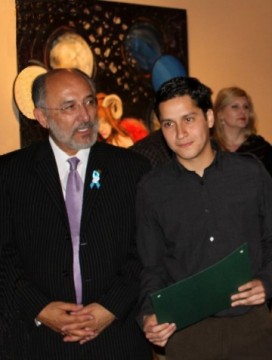
Cal Poly Pomona students and staff march to the CLA building as they respond in an uproar to last week's recommendations to cut the fine arts program at the school. May 4, 2010. Image via The Inland Valley Daily Bulletin.
Art’s place in government-funded institutions in our country has always been precarious. And with the Golden State sinking ever-deeper into the red, California-sponsored art programs are fighting for survival. But how can art demonstrate its value? Sure, we can cite ways in which arts education raises test scores for young students, but what happens after the SATs are over? Defending art in higher education–programs that aim to teach students how to become artists–is as slippery as defending art itself.
Last spring, my Looking at Los Angeles co-columnist Catherine Wagley and guest blogger Marc Herbst chronicled protest actions staged in response to California’s unprecedented cuts to state-funded higher education, and the concurrent — and also unprecedented–fee increases. This year, the state government has scaled back its cuts to higher education and even given universities hundreds of millions in restoration funds from the state, as well as federal stimulus funds. But Fine Art students at Cal Poly Pomona, one of 23 California State University campuses, are still feeling the squeeze. The Provost, Marten denBoer, has recommended the total elimination of the Fine Art major. In two weeks, the art department will have the opportunity to formally respond before a final decision is made.
As an adjunct lecturer in Cal Poly Pomona’s Art Department in Fall of 2009, I was profoundly impressed with the students’ commitment to not only to their work, but the department itself. This week, I spoke with Babette Mayor, chair of the Art Department, about the program’s struggle for survival, the community response, and what you — yes, you!– can do to help.
Lily Simonson: What is the history of the Art Department at CSU Pomona?
Babette Mayor: The B.A. in Art was created in 1974 as part of a university-wide initiative to bring arts and humanities education to a polytechnical school…In the late 80s, [there was a] growing interest in Graphic Design and the development of computers. Now the department has two degrees: a BA in Art with options in Fine arts and Art History, and a BFA in Graphic Design.
LS: How have California’s longstanding budget problems affected the art department over the long term?
BM: When I first [joined the faculty] in 1990, we had 9 faculty [members]. And it hasn’t changed very much. We have now 10 faculty. But the number of majors has dramatically increased. We’ve had a number of hires in graphic design because that particular area was growing. But the University has not replaced any of the Fine Art faculty that have retired.
LS: So requests for faculty position hires in Graphic Design and Art History have been responded to, but not Fine Art.
BM: Correct. And now two of the three [remaining] Fine Art faculty have started their FERP [Faculty Early Retirement Program]. We need to replace those positions; we need that support to strengthen the Fine Arts area.

Provost Marten denBoer and College of Environmental Design Dean Michael Woo, discuss the future of Fine Art at Cal Poly Pomona. Image via "Fight to Save Fine Art and Art History at CSU Pomona" Facebook Group.
LS: Can you talk about the current crisis that the Fine Arts program is facing?
BM: The Provost, Marten denBoer, sent us a formal letter in June, recommending the elimination of the fine arts option. The Department must respond to that proposal on November 12. We will present our response to the College Curriculum Committee.
The process began last year [following unprecedented statewide higher education cuts] with this initiative from the provost to examine all programs that had less than 150 majors. There were 34 programs. And he was very adamant that he was going to eliminate 10 to 12 of those programs. But now, Fine Art is the only program that he has actually recommended to be eliminated.
They are claiming that it’s a budgetary thing. But these are faculty lines that we have and they’re just not replacing them.
LS: This failure to replace faculty has been going on for ten years, and they have waited for the last three standing to retire, and now they are recommending elimination. The art department has a relatively small operating budget, correct?
BM: Correct.
[Excerpt from public letter ]: “Since joining the College of Environmental Design in 1994, the Art Department has produced the most FTE’s (this equates into financial resources) of any department. It is a documented fact that when the College needed to fulfill an FTE target they would elicit support from Art. Art’s contribution to the production of those FTE’s has helped the college maintain and fund other more expensive departments.”
LS: Why do you think it’s important for university institutions to have art majors, rather than just offering art classes to students from other fields?
BM: Firstly, our courses do serve other departments. Apparel, Merchandising and Management – we fulfill a component of their degree. Landscape Architecture students are required to take our drawing courses. And we want to expand on that.
But historically, an art department is part of the university culture. It’s important–I like to say it’s the foundation of our culture. It is more important than ever, because we are so visually oriented. Students are very sophisticated when it comes to visual imagery and visual literacy. We’re all about critical thinking, that’s what we do. On a class by class basis, it’s constant. And maybe we haven’t communicated that successfully. Art is problem solving as well as problem seeking.

Daniel Hanson, a Cal Poly Pomona Graduate Student solicits community support for the Fine Art option at a downtown Pomona art walk. Image via "Fight to Save Fine Art and Art at CSU Pomona" Facebook Group.
In addition, the University has launched a series of initiatives to go green. If there’s no Fine Art option at Cal Poly Pomona, we would not be able to serve our local students from the Pomona area. They would have to commute to another Cal State campus to study Fine Art, and thus we would be contributing to greenhouse emissions and all the environmental problems that we’re trying to stop.
LS: What kind of response have you received from the community?
BM: The community support has been fantastic. Last year, we set up information tables at the various second Saturdays in downtown Pomona and we distributed information and solicited letters of support. We received over 800 letters and delivered them to assemblymen and senators in our district with a letter explaining what was going on and requesting their support. And we did get support from them.
We have also solicited support from the Pomona Unified School District, because they are one of our feeder schools and they appreciate our program and think it’s a great program. We have the support of the Pomona Arts Colony, and the support of the Cal Poly Union.
We delivered those same 800 letters to [University] President Ortiz. I’ve asked some of local constituents, who may have already signed support letters, to write personalized letters that address our value to the community.
LS: So who has the ultimate say?
BM: After we present to the College Curriculum Committee, they present their response to our Dean, who then presents his response to the Provost. The [Academic] Senate then responds to the Provost. But the president [of the University] has the ultimate say.
LS: What can readers of this blog do to help the department?
BM: The president received literally hundreds of letters last year. And it’s dwindling it, so we need to publicize the crisis, and continue to send letters.
Form letters can be found on the Art Department website and emailed directly to President Ortiz, or sent to:
President Michael Ortiz
Cal Poly Pomona University
3801 West Temple Ave.
Pomona, CA 91768

President Michael Ortiz with student Pedro Martinez at the Art Department's May 2010 Award Ceremony and Senior Exhibition. Image via "Fight to Save Fine Art and Art at CSU Pomona" Facebook Group.




Pingback: ArtRubicon Visual Arts Weekly Redux, week ending Nov 6 | ArtRubicon Visual Arts Magazine